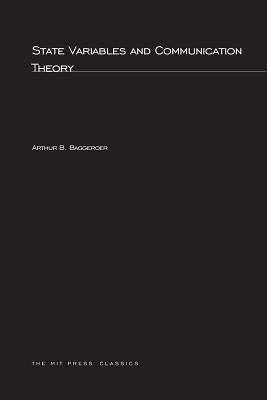
- We will send in 10–14 business days.
- Author: Arthur B Baggeroer
- Publisher: MIT Press
- ISBN-10: 026252354X
- ISBN-13: 9780262523547
- Format: 15 x 22.4 x 1.3 cm, softcover
- Language: English
- SAVE -10% with code: EXTRA
Reviews
Description
Although state variable concepts are a part of modern control theory, they have not been extensively applied in communication theory. The purpose of this book is to demonstrate how the concepts and methods of state variables can be used advantageously in analyzing a variety of communication theory problems. In contrast to the impulse response and covariance function description of systems and random processes commonly used in the analysis of communication problems, Professor Baggeroer points out that a state variable approach describes these systems and processes in terms of differential equations and their excitation, which is usually a white-noise process. Theoretically, such a description provides a very general characterization on which a large class of systems, possibly time varying and nonlinear, can be modeled. Practically, the state variable approach often provides a more representative physical description of the actual dynamics of the systems involved and, most importantly, can lead to solution techniques that are readily implemented on a computer and that yield specific numerical results.
The work focuses on how state variables can be used to solve several of the integral equations that recur in communication theory including, for example, the Kahunen-Loeve theorem, the detection of a known signal in the presence of a colored noise, and the Wiener-Hopf equation. The book is divided into two parts. The first part deals with the development from first principles of the state variable solution techniques for homogeneous and inhomogeneous Fredholm integral solutions. The second part considers two specific applications of the author's integral equation theory: to optimal signal design for colored noise channels, and to linear estimation theory.
The main thrust of the material presented in this book is toward finding effective numerical procedures for analyzing complex problems. Professor Baggeroer has combined several different mathematical tools not commonly used together to attack the detection and signal design problems. Numerous examples are presented throughout the book to emphasize the numerical aspects of the author's methods. If the reader is familiar with detection and estimation theory and with deterministic state variable concepts, the ideas, techniques, and results contained in this work will prove highly relevant, if not directly applicable, to a large number of communication theory problems.
MIT Research Monograph No. 61
EXTRA 10 % discount with code: EXTRA
The promotion ends in 18d.08:15:44
The discount code is valid when purchasing from 10 €. Discounts do not stack.
- Author: Arthur B Baggeroer
- Publisher: MIT Press
- ISBN-10: 026252354X
- ISBN-13: 9780262523547
- Format: 15 x 22.4 x 1.3 cm, softcover
- Language: English English
Although state variable concepts are a part of modern control theory, they have not been extensively applied in communication theory. The purpose of this book is to demonstrate how the concepts and methods of state variables can be used advantageously in analyzing a variety of communication theory problems. In contrast to the impulse response and covariance function description of systems and random processes commonly used in the analysis of communication problems, Professor Baggeroer points out that a state variable approach describes these systems and processes in terms of differential equations and their excitation, which is usually a white-noise process. Theoretically, such a description provides a very general characterization on which a large class of systems, possibly time varying and nonlinear, can be modeled. Practically, the state variable approach often provides a more representative physical description of the actual dynamics of the systems involved and, most importantly, can lead to solution techniques that are readily implemented on a computer and that yield specific numerical results.
The work focuses on how state variables can be used to solve several of the integral equations that recur in communication theory including, for example, the Kahunen-Loeve theorem, the detection of a known signal in the presence of a colored noise, and the Wiener-Hopf equation. The book is divided into two parts. The first part deals with the development from first principles of the state variable solution techniques for homogeneous and inhomogeneous Fredholm integral solutions. The second part considers two specific applications of the author's integral equation theory: to optimal signal design for colored noise channels, and to linear estimation theory.
The main thrust of the material presented in this book is toward finding effective numerical procedures for analyzing complex problems. Professor Baggeroer has combined several different mathematical tools not commonly used together to attack the detection and signal design problems. Numerous examples are presented throughout the book to emphasize the numerical aspects of the author's methods. If the reader is familiar with detection and estimation theory and with deterministic state variable concepts, the ideas, techniques, and results contained in this work will prove highly relevant, if not directly applicable, to a large number of communication theory problems.
MIT Research Monograph No. 61


Reviews